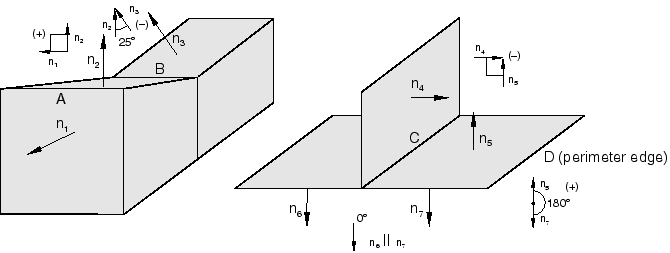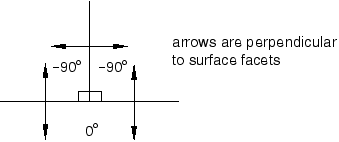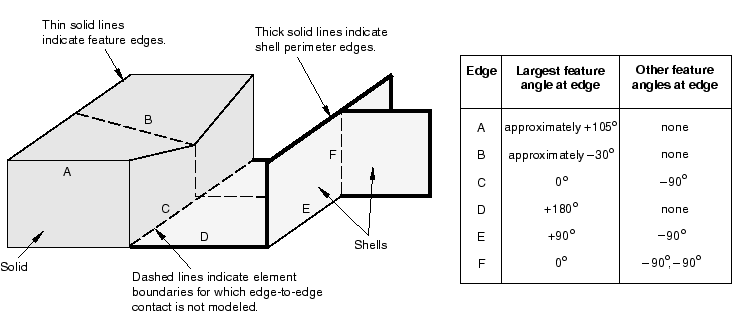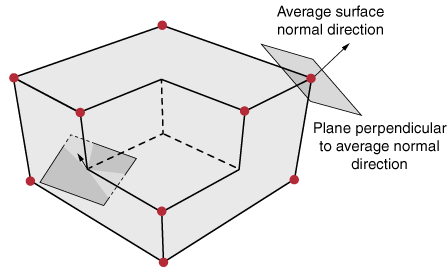Surface properties for general contact in Abaqus/Standard | |||||||||
|
| ||||||||
ProductsAbaqus/StandardAbaqus/CAE
Assigning surface properties
You can assign nondefault surface properties to surfaces involved in general contact interactions. These properties are considered only when the surfaces are involved in general contact interactions; they are not considered when the surfaces are involved in other interactions such as contact pairs. The general contact algorithm does not consider surface properties specified as part of the surface definition.
Surface properties for general contact in Abaqus/Standard are assigned at the beginning of an analysis and cannot be modified across steps.
The surface names used to specify the regions with nondefault surface properties do not have to correspond to the surface names used to specify the general contact domain. In many cases the contact interaction will be defined for a large domain, while nondefault surface properties will be assigned to a subset of this domain. Any surface property assignments for regions that fall outside the general contact domain will be ignored. The last assignment will take precedence if the specified regions overlap.
Input File Usage
SURFACE PROPERTY ASSIGNMENT, PROPERTY
This option must be used in conjunction with the CONTACT option and should appear at most once for each value of the PROPERTY parameter discussed below; the data line can be repeated as often as necessary to assign surface properties to different regions.
Abaqus/CAE Usage
Interaction module: Create Interaction: General contact (Standard): Surface Properties
![]()
Geometry-based corrections for curved surfaces
Contact calculations are based on unsmoothed, faceted representations of the finite element surfaces in a general contact domain. For curved surfaces, the finite element representation of a surface can deviate significantly from the original geometry that was used to generate the finite element mesh. A contact smoothing technique based on the original geometric representation can be employed for a more realistic simulation of contact interactions between curved surfaces, resulting in improved accuracy of stresses and distances between the contacting surfaces. This contact smoothing technique is discussed in more detail in Smoothing contact surfaces in Abaqus/Standard.
![]()
Surface thickness
The default surface thickness is equal to the original parent element thickness. Alternatively, you can specify a value for the surface thickness or a thickness scaling factor. A nonzero thickness can be assigned to solid element surfaces; for example, to model the effect of a finite thickness surface coating.
Using the original parent element thickness
The default surface thickness is equal to the original parent element thickness.
Input File Usage
SURFACE PROPERTY ASSIGNMENT, PROPERTY=THICKNESS surface, ORIGINAL (default)
If the surface name is omitted, a default surface that encompasses the entire general contact domain is assumed.
Abaqus/CAE Usage
Interaction module: Create Interaction: General contact (Standard): Surface Properties: Surface thickness assignments: Edit: Select surface, click the arrows to transfer surface to list of thickness assignments, and enter ORIGINAL in the Thickness column.
Specifying a value for the surface thickness
You can specify the surface thickness value directly.
Input File Usage
SURFACE PROPERTY ASSIGNMENT, PROPERTY=THICKNESS surface, value
If the surface name is omitted, a default surface that encompasses the entire general contact domain is assumed.
Abaqus/CAE Usage
Interaction module: Create Interaction: General contact (Standard): Surface Properties: Surface thickness assignments: Edit: Select surface, click the arrows to transfer surface to list of thickness assignments, and enter a value for the surface thickness magnitude in the Thickness column.
Applying a scale factor to the surface thickness
You can apply a scale factor to any value of the surface thickness. For example, if you specify that the original parent element thickness should be used for surf1 and apply a scale factor of 0.5, a value of one half the original parent element thickness will be used for surf1 when it is involved in a general contact interaction (all other surfaces included in the general contact domain will use the default original parent element thickness). Scaling the surface thickness in this way can be used to avoid initial overclosures in some situations. Abaqus/Standard will automatically adjust surface positions to resolve initial overclosures (see Controlling initial contact status in Abaqus/Standard) associated with general contact. However, if nodal position adjustments are undesirable (for example, if they would introduce an imperfection in an otherwise flat part, resulting in an unrealistic buckling mode), you may prefer to reduce the surface thickness and avoid the overclosures entirely.
Input File Usage
SURFACE PROPERTY ASSIGNMENT, PROPERTY=THICKNESS surface, value or label, scale_factor
If the surface name is omitted, a default surface that encompasses the entire general contact domain is assumed.
Abaqus/CAE Usage
Interaction module: Create Interaction: General contact (Standard): Surface Properties: Surface thickness assignments: Edit: Select surface, click the arrows to transfer surface to list of thickness assignments, and enter a Scale Factor.
![]()
Surface offset
A surface offset is the distance between the midplane of a thin body and its reference plane (defined by the nodal coordinates and element connectivities). It is computed by multiplying the offset fraction (specified as a fraction of the surface thickness) by the surface thickness and the element facet normal. This defines the position of the midsurface and, thus, the position of the body with respect to the reference surface; the coordinates of the nodes on the reference surface are not modified. Surface offsets can be specified only for surfaces defined on shell and similar elements (i.e., membrane, rigid, and surface elements). Surface offsets specified for other elements (e.g., solid or beam elements) will be ignored. By default, surface offsets specified in element section definitions will be used in the general contact algorithm.
You specify the surface offset as a fraction of the surface thickness. The surface offset fraction can be set equal to the offset fraction used for the surface's parent elements or to a specified value. Surface offsets specified for general contact do not change the element integration.
Input File Usage
Use the following option to use the surface offset fraction from the surface's parent elements (default):
SURFACE PROPERTY ASSIGNMENT, PROPERTY=OFFSET FRACTION surface, ORIGINAL
Use the following option to specify a value for the surface offset fraction:
SURFACE PROPERTY ASSIGNMENT, PROPERTY=OFFSET FRACTION surface, offset
The offset can be specified as a value or a label (SPOS or SNEG). Specifying SPOS is equivalent to specifying a value of 0.5; specifying SNEG is equivalent to specifying a value of −0.5.
Abaqus/CAE Usage
Interaction module: Create Interaction: General contact (Standard): Surface Properties: Shell/Membrane offset assignments: Edit: Select surface, and click the arrows to transfer surface to list of offset assignments. In the Offset Fraction column, enter ORIGINAL to use the surface offset fraction from the surface's parent elements, enter SPOS to use a surface offset fraction of 0.5, enter SNEG to use a surface offset fraction of −0.5, or enter a value for the surface offset fraction.
![]()
Feature edges
Feature edges of a model are defined on beam and truss elements and on edges of faces (perimeter and otherwise) of solid and structural elements. General contact in Abaqus/Standard includes an edge-to-surface contact formulation and an edge-to-edge contact formulation (as supplements to the surface-to-surface formulation), as discussed in About general contact in Abaqus/Standard. By default, the edge-to-surface contact formulation considers “edges” of beam and truss elements, perimeter edges, and edges corresponding to initial geometric feature angles of 45° and higher. You can control the feature edge criterion globally or locally for both edge-to-surface and edge-to-edge contact. Feature edge criteria have no effect on “edges” of beam and truss elements—they are activated by their inclusion in the contact domain.
Some aspects of the contact property assignment options apply only to the surface-to-surface formulation (see Contact properties for general contact in Abaqus/Standard for further discussion of contact properties for general contact). The edge-to-surface and edge-to-edge formulations always use the penalty enforcement method and only involve displacement degrees of freedom. For example, the edge-to-surface formulation or the cross edge-to-edge formulation does not contribute to thermal gap conductance across a contact interface.
Specifying a cutoff feature angle
The feature angle is the angle formed between normals of two facets connected to an edge. The angles between facets are based on the initial configuration. A negative angle results at concave meetings of facets; therefore, these edges are never included in the contact domain. Figure 1 shows some examples of how the feature angle is calculated for different edges.

The feature angle for edge A is 90° (the angle between and ); the feature angle for edge B is −25° (the angle between and ). Edge C forms a T-intersection with three facets (shown in two dimensions in Figure 2); its feature angles are 0°, −90°, and −90°.

Perimeter edges (for example, edge D in Figure 1) can be thought of as a special type of feature edge where the feature angle is 180°.
If a feature angle criterion is in effect (by default or because you specified it), geometric edges of solid and shell bodies with feature angles greater than or equal to the specified angle are included in the general contact domain. The contact inclusion and exclusion options (discussed in About general contact in Abaqus/Standard) apply to the surface-to-surface contact formulation, the edge-to-surface contact formulation, and the edge-to-edge contact formulation (and further control which portions of surfaces may interact with either formulation). The sign of the feature angle is considered when determining whether or not a geometric feature edge should be included in the general contact domain. For example, if a cutoff feature angle of 20° were specified, edge A would be activated as a feature edge in the contact model (because the feature angle of 90° is greater than the cutoff of 20°) but edges B and C would not be activated (because the feature angle at edge B is −25° and the maximum feature angle at edge C is 0°, which are both less than the cutoff of 20°). The cutoff feature angle cannot be set to less than 0° or more than 180°. Specifying a small cutoff feature angle (for example, less than 20°) may considerably increase run time without a major impact on the results compared to a larger cutoff angle (> 20°). The default feature angle cutoff for edge-to-surface contact is 45°, while the default is not to include feature edges in edge-to-edge contact. The criterion for including edges for edge-to-surface contact can be different from the criterion for including edges for edge-to-edge contact; the two are completely independent.
Figure 3 illustrates further how the feature angle is used to determine which geometric feature edges are activated in the general contact domain.

The table to the right of the figure lists the feature angle values for various edges in the model. Edges connected to shell facets, but not on the shell perimeter, have more than one corresponding feature angle. The largest feature angle at an edge is compared to the default or specified cutoff feature angle. For example, if the default cutoff feature angle of 45° is in effect, edges A, D, and E would be considered for edge-to-surface contact, while edges B, C, and F would be ignored for edge-to-surface contact.
Input File Usage
SURFACE PROPERTY ASSIGNMENT, PROPERTY=FEATURE EDGE CRITERIA surface, feature_angle_value_edge_to_surface, , feature_angle_value_edge_to_edge
If the surface name is omitted, a default surface that encompasses the entire general contact domain is assumed.
Abaqus/CAE Usage
Use the following options to specify the cutoff feature angle for edge-to-surface contact:
Interaction module: Create Interaction: General contact (Standard): Surface Properties: Feature edge criteria assignments: Edit: Select the surface, click the arrows to transfer the surface to the list of feature assignments, and enter a numerical value for the cutoff feature angle (in degrees) in the Feature Edge Criteria column
Controlling the cutoff feature angle for edge-to-edge contact is not supported in Abaqus/CAE.
Specifying that only perimeter edges should be activated
You can specify that only perimeter edges should be considered by the edge-to-surface and/or edge-to-edge formulation globally or in a local region. Perimeter edges occur on “physical” perimeters of shell elements and on “artificial” edges that occur when a subset of exposed facets on a body are included in the general contact domain. The classification of an edge as being on the perimeter of the contact domain (or as a geometric edge with a particular feature angle) is based on the contact inclusion and contact exclusion definitions and the mesh characteristics. When structural elements share nodes with continuum elements, the perimeter edges will not be activated on the structural elements because the criterion to designate them as such is no longer satisfied.
Input File Usage
SURFACE PROPERTY ASSIGNMENT, PROPERTY=FEATURE EDGE CRITERIA surface, PERIMETER EDGES, , PERIMETER EDGES
If the surface name is omitted, a default surface that encompasses the entire general contact domain is assumed.
Abaqus/CAE Usage
Use the following options to specify that only perimeter edges should be included for edge-to-surface contact:
Interaction module: Create Interaction: General contact (Standard): Surface Properties: Feature edge criteria assignments: Edit: Select the surface, click the arrows to transfer the surface to the list of feature assignments, and enter PERIMETER in the Feature Edge Criteria column
Specifying that only perimeter edges should be included for edge-to-edge contact is not supported in Abaqus/CAE.
Specifying that feature edges should not be included
You can specify that no edges should be considered by the edge-to-surface formulation globally or in a local region. However, doing so does not deactivate “contact edges” associated with beam and truss elements. By default, feature edges are not included for edge-to-edge contact.
Input File Usage
SURFACE PROPERTY ASSIGNMENT, PROPERTY=FEATURE EDGE CRITERIA surface, NO FEATURE EDGES
If the surface name is omitted, a default surface that encompasses the entire general contact domain is assumed.
Abaqus/CAE Usage
Use the following options to specify that no feature edges are included for edge-to-surface contact:
Interaction module: Create Interaction: General contact (Standard): Surface Properties: Feature edge criteria assignments: Edit: Select the surface, click the arrows to transfer the surface to the list of feature assignments, and enter NONE in the Feature Edge Criteria column
![]()
Vertex nodes
Vertex nodes of a model are defined on convex corners of shell and structural surfaces and end points and kinks in beam and truss surfaces. Vertex nodes are eligible to participate as vertices in the vertex-to-surface contact formulation for general contact in Abaqus/Standard. The vertex-to-surface contact formulation is discussed in About general contact in Abaqus/Standard.
Some aspects of the contact property assignment options apply only to the surface-to-surface formulation (see Contact properties for general contact in Abaqus/Standard for further discussion of contact properties for general contact). The edge-to-surface and vertex-to-surface formulations always use the penalty enforcement method and involve only displacement degrees of freedom. For example, the vertex-to-surface formulation does not contribute to thermal gap conductance across a contact interface.
Usually, only a small subset of surface nodes satisfy one of the criteria for being a vertex node. The following algorithm is used to determine if a node satisfies the vertex criterion for a convex corner of a solid or shell-like surface, based on the original configuration:
-
Abaqus/Standard computes an average surface normal direction for the node and an associated plane that passes through the node and is perpendicular to this direction. Two examples of such normal directions and planes are shown in Figure 4.
-
The node is considered a vertex node if each surface edge emanating from this node is “inside” of this plane (that is, on the opposite side of this plane as the average surface normal direction vector) and forms an angle greater than or equal to the vertex angle threshold with this plane, by default. For example, the example node on the right of Figure 4 has all adjacent surface edges on the “inside” of the plane perpendicular to the average surface normal direction. For the other example node in Figure 4 for which an average normal direction and corresponding plane is shown, two adjacent surface edges lie outside of this plane (on the same side as the outward normal direction vector), so this node would not satisfy this vertex node criterion.
Figure 4. Examples of average surface normal directions and corresponding planes associated with vertex node criterion.
The following additional vertex criterion is applied at nodes of perimeter feature edges, based on the original configuration:
-
Abaqus/Standard computes an average outward perimeter direction for the node and an associated plane that passes through the node and is perpendicular to this direction.
-
The node is considered a vertex node if each feature edge connected to the node is inside of this plane and forms an angle greater than or equal to the vertex angle threshold with this plane, by default.
The following vertex criterion is applied at nodes of feature edges associated with beams and trusses, based on the original configuration:
-
Abaqus/Standard computes an average edge direction for the node and an associated plane that passes through the node and is perpendicular to this direction.
-
If the average edge direction is zero, the node is not a vertex node; otherwise, the node is considered a vertex node if each feature edge connected to the node forms an angle greater than or equal to the vertex angle threshold with this plane, by default.
The default vertex angle threshold is 20°. The circular dots in Figure 5 represent examples of nodal locations that would satisfy one of the vertex node criteria, with the default vertex angle threshold in effect.

Specifying that all vertex nodes should be included
You can specify that all vertex nodes should be considered by the vertex-to-surface formulation globally or in a local region.
Input File Usage
SURFACE PROPERTY ASSIGNMENT, PROPERTY=VERTEX CRITERIA surface, ALL VERTICES
If the surface name is omitted, a default surface that encompasses the entire general contact domain is assumed.
Specifying a vertex angle threshold
You can control the vertex criteria globally or locally.
Input File Usage
SURFACE PROPERTY ASSIGNMENT, PROPERTY=VERTEX CRITERIA surface, vertex_angle_threshold
If the surface name is omitted, a default surface that encompasses the entire general contact domain is assumed.
Specifying that vertex nodes should not be included
You can specify that no vertex nodes should be considered by the vertex-to-surface formulation globally or in a local region. However, doing so does not deactivate “contact edges” associated with beam and truss elements.
Input File Usage
SURFACE PROPERTY ASSIGNMENT, PROPERTY=VERTEX CRITERIA surface, NO VERTICES
If the surface name is omitted, a default surface that encompasses the entire general contact domain is assumed.